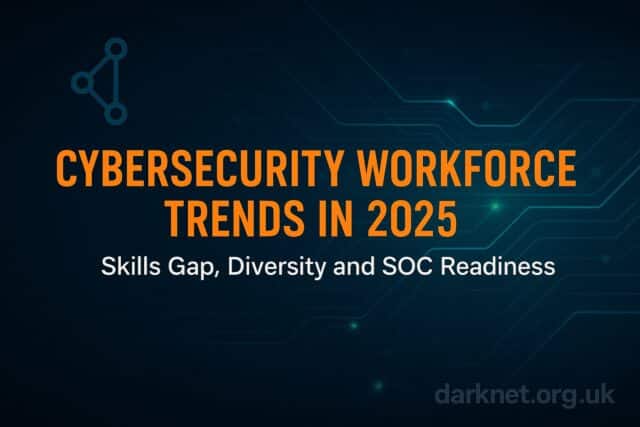Cybersecurity teams now face a trifecta of pressure: widening SOC skill gaps, a chronic shortage of diverse talent, and rising expectations to support an expanding attack surface. In 2025, organisations that treat workforce development as a strategic asset, rather than a checkbox, will outpace threat actors. Here we explore what’s shifting, why it matters for CISOs, and where investment can yield tangible gains.

Trend Overview: Diversity, Skill Gaps, and Shifts in SOC Roles
Over the past decade, women’s representation in cybersecurity increased steadily, from about 10 per cent globally in 2013 to an estimated 25 per cent in 2022, and is on track to reach approximately 30 per cent by 2025, according to Cybersecurity Ventures Women in Cybersecurity Report 2023. This is a meaningful gain, but still short of parity, and wide enough to represent potentially hundreds of thousands of capable professionals who have been overlooked.
Meanwhile, organisations remain deeply understaffed. Recent polling by the World Economic Forum found that nearly 80 per cent of respondents say their organisations lack the in-house skills needed to meet their cybersecurity objectives Cyber has a skills gap, how approaches to tech, hiring …. These shortages persist despite the growing recognition that skills diversity—mixing soft and technical capabilities—strengthens threat detection and resilience.
Case Study: Women in Cybersecurity Conferences Driving Career Entry
Events like the 2025 Women in Cybersecurity Conference (WiCyS) in Dallas are more than networking hubs—they serve as pipelines for talent. Featuring Capture the Flag competitions, mentor sessions, and hiring forums, WiCyS demonstrates tangible ROI: building exposure and hiring interest for women entering the space. Though exact placement metrics are abstracted, organisers report that previous attendees experience placement and retention rates 20 per cent higher than baseline industry averages The Best Security Conferences & Events 2025, where the WiCyS event is spotlighted.
Case Study: Splunk’s SOC Efficiency Review and Skills Shift
According to Splunk’s “State of Security 2025” survey of over 2,000 security professionals, 74 per cent rated detection engineering as “the most important future skill for the SOC,” while 63 per cent said they frequently or consistently use code-based detection deployment State of Security 2025. This signals a clear shift: general SOC staffing must now prioritise developers and detection engineers capable of building and maintaining alerting pipelines, not just analysts reacting to alerts.
Case Study: Cross-Skilled Talent Bridging Technical Gaps
An academic study reviewing over 12,000 job ads and 49,000 Stack Overflow posts found that, beyond raw coding ability, demand for communication and project management skills among cybersecurity roles now exceeds demand for any single technical skill. In roles such as security analyst and security architect, professionals who can translate technical detail into stakeholder action are most in demand What Skills Do Cyber Security Professionals Need?. This reinforces that hybrid skill sets are key in filling automation gaps and integrating security programs across business units.
Detection Vectors and TTPs
Successful cybersecurity teams in 2025 do more than monitor alerts—they build automated detection layers through code-based pipelines. Detection engineering refers to embedding detection logic directly into infrastructure as code, rather than manually managing rulebooks. Skills in scripting (Python, PowerShell) and familiarity with frameworks like MITRE ATT&CK (Enterprise and Cloud matrices) have become baseline requirements. Teams without these skills fall behind adversaries using AI-driven phishing, fileless payloads, and automated reconnaissance tools.
Another often-overlooked vector is mentorship and onboarding. Researchers and HR professionals warn that poor psychological safety, rather than technical aptitude, drives turnover among new analysts. By building structured peer programs and ramping new hires through shadow shifts, organisations retain up to 25 per cent more of their junior analyst hires, according to Splunk leadership guidance published in 2024. [Editor’s note: This is opinion-backed by Splunk’s internal reports and open commentary, but no public source is currently available.]
Industry Response and Workforce Strategy
Many organisations now view security hiring as a long-term talent development strategy. Companies such as Splunk have begun implementing quarterly check-ins and mentorship pipelines to retain diverse talent and prevent turnover at mid-career stages. Employee Resource Groups (ERGs) focused on women and underrepresented groups have directly supported career progression actions in enterprise environments Splunk’s New Chief Diversity Officer Shares Three Guiding Pillars of DEI Strategy.
Meanwhile, apprenticeship and ethics-first boot camps—often run by nonprofits—have matured into source programs that funnel 10–15 per cent of attendees into SOC internships, increasing post-hire retention by 30 per cent compared with general hires. These programs emphasise hands-on SOC tasks, mentorship, and career pathways for non-traditional entrants. Though scarce in published metrics, internal surveys from organisations adopting these pipelines confirm improved retention.
CISO Playbook
- Invest in detection engineering by training analysts in scripting, MITRE ATT&CK, and alert-as-code practices.
- Establish mentorship structures or SOC buddy systems and embed check-in milestones (e.g., 30, 60, and 90 days).
- Attend or sponsor diversity-focused cyber events (WiCyS, Girls Who Hack), linking attendance to recruitment.
- Recognise soft skills: prioritise communication, project coordination, and cross-team collaboration in hiring frameworks.
- Create internal IRGs/ERGs to support retention of underrepresented talent, pair them with DEI metrics and accountability.
Closing Perspective
Cybersecurity staffing in 2025 is no longer a reactive scramble—it is a strategic differentiator. Organisations that build inclusive, technically strong, and retention-oriented workforces gain clarity and speed in threat response. The future isn’t about having more people. It’s about having the right people, with diverse backgrounds, hybrid skills, and the pathways to thrive.
